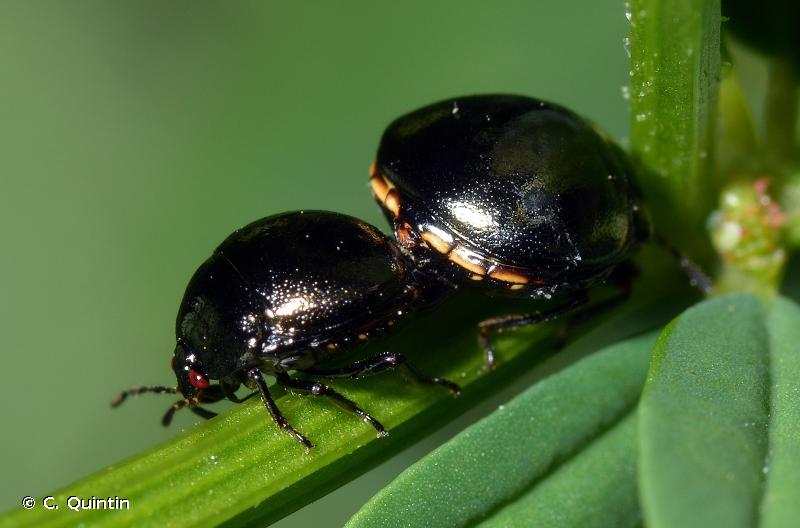
cd_nom

| Author : H. Bouyon |
 |
To get the picture, please visit:
Hervé BOUYON
email : herve.bouyon@wanadoo.fr
Any reuse of one or more photographs on this site is subject to an authorization request from the author.
Link to the Code of Intellectual Property (Legifrance)

| Author : C. Quintin |
 |
To get the picture, please visit:
Christophe Quintin
email : inpn@mnhn.fr
Despite the Creative Commons license, please inform the author of the use which will be made of his photo
Taille : 3,5 – 4,6 mm
Diagnose :Petite punaise de couleur noir brillant, dont le corps est large, ovale et bombé comme une coccinelle. Sa forme est caractéristique avec un corps aussi large que long (famille des Plataspidae). Le scutellum est très développé et recouvre entièrement les ailes et l'abdomen. Les ailes sont glissées sous le scutellum comme à l'intérieur d'un étui. Le scutellum forme un seul bloc et n'est pas divisé en deux comme chez les coléoptères qui ont des élytres séparés au centre et non recouverts par le scutellum.
Détermination : Simple.
Espèces proches :Pas de risque de confusion avec sa taille, sa couleur noir brillant et sa forme globulaire caractéristiques, si ce n'est avec de petits coléoptères de la famille des Chrysomelidae auxquels l'espèce ressemble superficiellement.
Période d'observation : Mai à septembre avec un pic important en juin.
Biologie-éthologie :Elle se nourrit exclusivement sur des plantes légumineuses herbacées, dont les coronilles, lathyrus, luzernes, mélilot, psoralea, sainfoins, vesces, ou arbustives, dont les bugranes, genêts, spartiers, en suçant directement leurs graines encore tendres, ou à travers leurs gousses.
Biogéographie et écologie :Espèce à vaste distribution paléarctique, présente jusqu'à 56° de latitude nord en Scandinavie, mais absente de Grande-Bretagne. Elle est répandue vers l'est jusqu'en Sibérie, Chine, Corée et Japon. On la rencontre en plaine et jusqu'à 1 700 m d'altitude, en général dans les lieux humides ou mésophiles : pâturages, prairies, pelouses, coteaux calcaires, jachères, landes, friches, lit de ruisseau, canaux d'irrigation, arrières dunes et cultures de légumineuses. Cette espèce est commune sur ces plantes nourricières et dans ces biotopes.
Roland Lupoli (),2019
Continental
Metropolitan France
Overseas
Marine
Metropolitan France
Overseas
The map presents a summary at the 10 x 10 km grid of the observation data for the species transmitted to the SINP. These data have been subjected to validation filters.
The map presents a reference distribution layer of the species at the scale of departments and marine sectors. The presence and absence data were established by expertise within a network of partners. This reference distribution is used in the validation process of the SINP data at the INPN level.
Corresponds to a report on the basis of at least one observation proved within a period of 10 years (20 years for little-known invertebrates) preceding the year and no presumption of extinction since obtaining the last data nor doubt on reproductive and implemented nature of this population. For migratory species, the presence indicated concerns areas of reproduction.
This status is based on one or more of the following criteria:
This point covers the absence, more difficult by nature to demonstrate than presence. This status is based on one or more of the following criteria:
This status must be assigned to a department in which the presence of the species is casual.
Particular case of absence due to a proven extinction less than a half century ago (older disappearances are treated as "no probable or definite").
In the state of knowledge, we can not comment on the presence or absence in the current department. This is the default status when not comprised in one of the previous categories or whenever there is doubt.
The map shows the global distribution of the species based on GBIF data (Global Biodiversity Information Facility).
